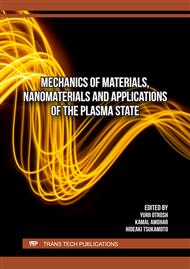[1]
S. Zhang, T. Li, Z. Li, Thermal field design of a large-sized SiC using the resistance heating PVT method via Simulations, Cryst. 13(12)2023, p.1638.
DOI: 10.3390/cryst13121638
Google Scholar
[2]
N. Zhang, X. Chen, Z. Li, Suppressing SiC crystal edge decomposition through pore-type crucible, Vac. 239(2025), pp.114369-114369.
DOI: 10.1016/j.vacuum.2025.114369
Google Scholar
[3]
B. Xiao, Application of high-frequency induction brazing in welding of base axis, Hot Working Technol. 38(9)2009, p.155.
Google Scholar
[4]
I. Artaki, U. Ray, H. M Gordon, Thermal degradation of rosin during high temperature solder reflow, Thermochim. Acta. 198(1992), pp.7-20.
DOI: 10.1016/0040-6031(92)85053-x
Google Scholar
[5]
B.J. Xu, H. Cui, P.Y. Chen, Effects of the thermal field on the diameter enlargement of 200 mm SiC by PVT method, Cryst. Eng. Comm. 27(9)2025, pp.1315-1324.
DOI: 10.1039/d4ce01063a
Google Scholar
[6]
X.Y. Hou, X.F. Hu, X.L Yang, Mechanism reveal of threading edge dislocation multiplication during the initial stage of 4H-SiC growth, Cryst. Growth Des. 25(11)2025, pp.3880-3887.
DOI: 10.1021/acs.cgd.5c00287.s001
Google Scholar
[7]
C.Y. Lee, S.J. Lee, J.H. Park, High-quality SiC crystal growth by temperature gradient control at initial growth stage, Solid State Phenom. 362(2024), pp.53-57.
DOI: 10.4028/p-brlys3
Google Scholar
[8]
X. Yu, J. Wang, B. Zhang, Influence of thin-film residual stress and surface impurities onfatigue life of deformable mirror, Infrared Laser Engineering, 48(9)2019, pp.200-206.
Google Scholar
[9]
J. Zhang, L. Ding, Z. Lin, Q. Li, J. He, X. Yang, N. Dong, Applications of functional fiber materials and optical waveguides, Acta Opt. Sin. 2(8)2025, pp.1-29.
Google Scholar
[10]
Y. Meng, One⁃dimensional topological coinless quantum walks inoptical waveguides, Chin. J. Quantum Electron 42(02)2025, pp.217-228.
Google Scholar
[11]
L. Zheng, C. Liu, Z.Q. Zhou, Long⁃term optical memory based on crystal waveguide, Chin. J. Quantum Electron 42(02)2025, pp.246-254.
Google Scholar
[12]
J.Q. Guo, Y. Yang, B. Raghothamachar, Mapping of lattice ltrain in 4H-SiC lrystals by synchrotron double-crystal X-ray topography, Electron. Mater. 47(2018), pp.903-909.
DOI: 10.1007/s11664-017-5789-x
Google Scholar
[13]
Y. Song, Z.W. Xu, M. Rommel, Defects distribution and evolution in selected-area helium ion implanted 4H–SiC, Ceram. Int. 50 (2024), pp.7691-7701.
DOI: 10.1016/j.ceramint.2023.12.096
Google Scholar
[14]
X. Xu, C Martin, Effect of annealing temperature on SiC wafer bow and warp, Mater. Res. Soc. 1069(2008), pp. D07-23.
DOI: 10.1557/proc-1069-d07-23
Google Scholar
[15]
B.Y. Zhang, A theoretical proof of G. wertheim stress-optic law, J. Gansu lianhe university 27(05)2013, pp.26-29.
Google Scholar
[16]
X.X. Xiong, X. L. Yang, X.F. Chen, Fabrication of 8-inch N-type 4H-SiC single crystal substrate with low dislocation density, J. Inorg. Mater. 38(11)2023, pp.1371-1372.
DOI: 10.15541/jim20230325
Google Scholar
[17]
P. Chen, Y.M. Zhang, Y.M. Zhang, Stability of the intrinsic defects in unintentionally doped 4H-SiC epitaxial layer, Acta Phys. Sin 59(05)2010, pp.3542-3546.
DOI: 10.7498/aps.59.3542
Google Scholar
[18]
B. Michel, G. Adam, M. Alexander, Identification of intrinsic defects in SiC: towards an understanding of defect aggregates by combining theoretical and experimental approaches, Phys. Status. Solidi. 245(7)2008, pp.1281-1297.
DOI: 10.1002/pssb.200844048
Google Scholar
[19]
N.T. Son, P. Carlsson, A. Gällström, Deep levels and carrier compensation in V-doped semi-insulating4H-SiC, Appl. Phys. Lett. 91(20)2007, pp.22111-0.
DOI: 10.1063/1.2814058
Google Scholar
[20]
W.E. Carlos, N.Y. Garces, E.R. Glaser, Annealing of multivacancy defects in 4H-SiC, Phys. Rev. 74(23)2006, pp.5201-0.
Google Scholar
[21]
B. Michel, G. adam, M. Alexander, Identification of intrinsic defects in SiC: Towards an understanding of defect aggregates by combining theoretical and experimental approaches, Phys. Status. Solidi. 245(7)2008, pp.1281-1297.
DOI: 10.1002/pssb.200844048
Google Scholar


